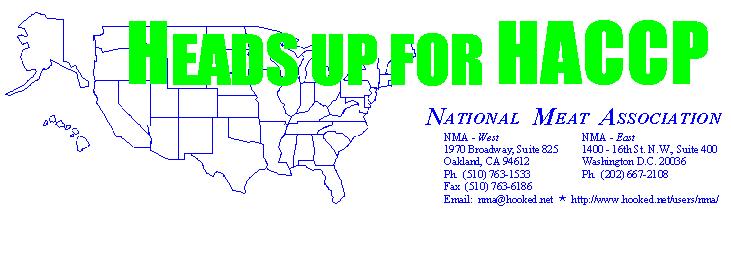

Edited by Jeremy Russell
December 8, 1997
HACCP PRINCIPLE #3: ESTABLISH CRITICAL
LIMITS FOR EACH CRITICAL CONTROL POINT
WHAT IS A CRITICAL LIMIT? By Lou Gast
, CEO HACCP Consulting Group L.L.C.In developing a HACCP plan, Critical Limits must be set for each preventive measure associated with each Critical Control Point (CCP). ( See Heads Up for HACCP, November 24, 1997, for definition of CCP). These Critical Limits (CLs) will set up processing "limits." Plant personnel must be able to control these processing limits to assure prevention, elimination, or reduction of hazards to acceptable levels. For example, a bone extractor will remove bones above a particular size that may be harmful if swallowed by a consumer.
Critical Limits may be set for such things as temperature, cooking time, and physical dimensions, such as bone fragments, humidity, pH, and water activity (aw). To find a Critical Limit that is able to prevent, eliminate or reduce a hazard, a plant�s HACCP Team must consult such sources as regulatory standards, guidelines, literature surveys, experimental studies, and industry experts. Using competent authorities to validate that the critical limits will control the identified hazard is the responsibility of the food industry, not the resident FSIS inspector or any of its supervisors.
Critical Limits for cooking beef patties have been well researched. These Critical Limits should be designed to eliminate the most heat-resistant vegetable pathogens, which are probably present in the product. For example, a preventive measure and Critical Limit for beef patties may be to cook them to a temperature of 160�F during one stage of processing. The oven temperature, however, may be set and monitored at +165�F so that the equipment used cooks all patties to at least 160�F. The HACCP Team must look at many variables, including the type of equipment used, the cooking time, the patty thickness, and the patty composition to determine the appropriate Critical Limit for this Critical Control Point. Documentation supporting the established Critical Limits must be available.
THIS IS A REAL CHANGE!
The two major regulatory revisions made in the July 25, 1996 Final Rule: Sanitation and HACCP Systems are contained in two entirely new sections of the Code of Federal Regulations. These new regulations are relatively brief but hugely comprehensive. They are contained in Part 416 for Sanitation and Part 417 for HACCP Systems. As a convenience for Heads Up For HACCP, NMA will provide a copy of the six pages in the bound CFR of these two parts that will play an increasingly critical role in the day-to-day management activities in meat plants; simply send a self-addressed, stamped (32�) envelope to Ira Perez at NMA-West with. A discussion of the HACCP verification procedures is included in a separate item for Heads Up For HACCP readers this week.
HACCP Information Online:
�